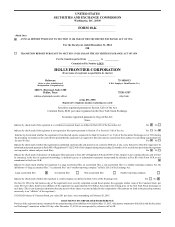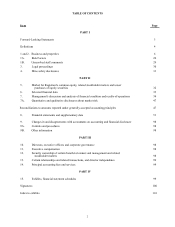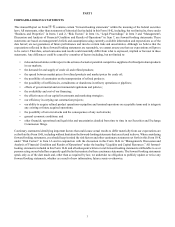HollyFrontier 2014 Annual Report Download - page 19
Download and view the complete annual report
Please find page 19 of the 2014 HollyFrontier annual report below. You can navigate through the pages in the report by either clicking on the pages listed below, or by using the keyword search tool below to find specific information within the annual report.
Table of Content
11
Crude Oil and Feedstock Supplies
Both of our Mid-Continent Refineries are connected via pipeline to Cushing, Oklahoma, a significant crude oil pipeline trading
and storage hub. The El Dorado and the Tulsa Refineries are located approximately 125 miles and 50 miles, respectively, from
Cushing, Oklahoma. Local pipelines provide direct access to regional Oklahoma crude production as well as access to United
States onshore, Gulf of Mexico, Canadian and other foreign crudes. The proximity of the refineries to the Cushing pipeline and
storage hub provides the flexibility to optimize their crude slate with a wide variety of crude oil supply options. Additionally, we
have transportation service agreements to transport Canadian crude oil on the Spearhead and Keystone Pipelines, enabling us to
transport Canadian crude oil to Cushing for subsequent shipment to either of our Mid-Continent Refineries.
We also purchase isobutane, natural gasoline, butane and other feedstocks for processing at our Mid-Continent Refineries. The El
Dorado Refinery is connected to Conway, Kansas, a major gas liquids trading and storage hub, via the Oneok Pipeline. From time
to time, other feedstocks such gas oil, naphtha and light cycle oil are purchased from other refiners for use at our refineries.
Southwest Region (Navajo Refinery)
Facilities
The Navajo Refinery has a crude oil processing capacity of 100,000 barrels per stream day and has the ability to process sour
crude oils into high-value light products such as gasoline, diesel fuel and jet fuel. For 2014, gasoline and diesel fuel (excluding
volumes purchased for resale) represented 54% and 38%, respectively, of our Southwest sales volumes.
The following table sets forth information about our Southwest region operations, including non-GAAP performance measures.
Years Ended December 31,
2014 2013 2012
Southwest Region (Navajo Refinery)
Crude charge (BPD) (1) 98,120 87,910 93,830
Refinery throughput (BPD) (2) 110,250 97,310 103,120
Refinery production (BPD) (3) 107,520 94,490 100,810
Sales of produced refined products (BPD) 106,870 94,830 99,160
Sales of refined products (BPD) (4) 115,620 104,320 104,620
Refinery utilization (5) 98.1% 87.9% 93.8%
Average per produced barrel (6)
Net sales $ 110.54 $ 117.79 $ 122.62
Cost of products (7) 94.58 103.88 95.70
Refinery gross margin (8) 15.96 13.91 26.92
Refinery operating expenses (9) 5.43 6.04 6.07
Net operating margin (8) $ 10.53 $ 7.87 $ 20.85
Refinery operating expenses per throughput barrel (10) $ 5.26 $ 5.89 $ 5.84
Feedstocks:
Sweet crude oil 13% 8% 2%
Sour crude oil 74% 72% 77%
Heavy sour crude oil 2% 11% 12%
Other feedstocks and blends 11% 9% 9%
Total 100% 100% 100%
Footnote references are provided under our Consolidated Refinery Operating Data table on page 8.
The Navajo Refinery's Artesia, New Mexico facility is located on a 561-acre site and is a fully integrated refinery with crude
distillation, vacuum distillation, FCC, ROSE (solvent deasphalter), HF alkylation, catalytic reforming, hydrodesulfurization, mild
hydrocracking, isomerization, sulfur recovery and product blending units. The operating units at the Artesia facility include newly
constructed units, older units that have been relocated from other facilities and upgraded and re-erected in Artesia, and units that
have been operating as part of the Artesia facility (with periodic major maintenance) for many years, in some very limited cases
since before 1970. Supporting Infrastructure includes approximately 2.0 million barrels of feedstock and product tankage, of which
0.3 million barrels of tankage are owned by HEP.
























